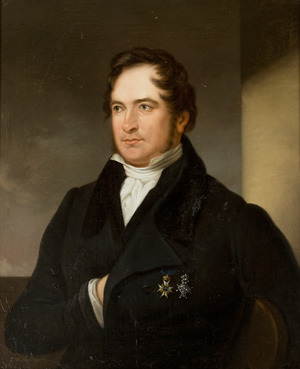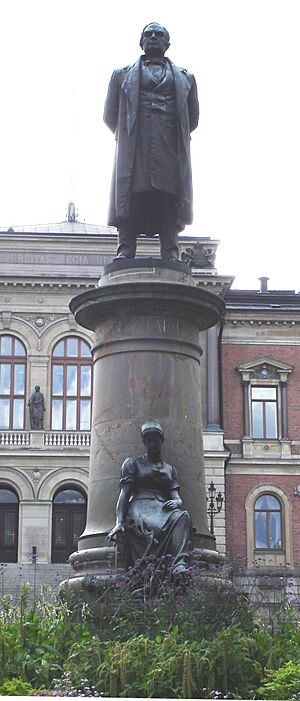Erik Gustaf Geijer facts for kids
Quick facts for kids
Erik Gustaf Geijer
|
|
|---|---|

Portrait by Carl Wilhelm Nordgren
|
|
| Born | 12 January 1783 |
| Died | 23 April 1847 (aged 64) |
Erik Gustaf Geijer (born January 12, 1783 – died April 23, 1847) was a very important Swedish writer, historian, poet, philosopher, and composer. He helped create a style called "National Romanticism" in Sweden. At first, he supported traditional ideas (this is called conservatism). But later in his life, he changed his mind and became a supporter of new ideas and freedom (this is called liberalism).
Contents
Biography
Erik Gustaf Geijer was born at Geijersgården, his family's home in Ransäter, Värmland. He went to school in Karlstad and then studied at the University of Uppsala. He earned his master's degree in 1806. In 1803, he won a history prize from the Royal Swedish Academy of Sciences.
In 1809, Geijer traveled to England. The next year, he started teaching history at Uppsala University. In 1817, he became a history professor there. Today, there is a statue at the university to remember him. He was also the head of Uppsala University several times.
Geijer was a member of the Church of Sweden clergy in the Riksdag of the Estates. This was a type of parliament in Sweden. He was also a member of the Swedish Academy from 1824. This is a group that works to improve the Swedish language and literature.
Geatish Society and The Viking
Geijer helped start a group called the Geatish Society (Swedish: Götiska förbundet). This group was interested in old Norse culture and history. In their first magazine, Iduna, Geijer's most famous poem, The Viking, was published. This poem described Vikings as brave heroes. It helped make old Norse culture popular again in Sweden.
Geijer also worked with Arvid August Afzelius to collect Swedish folk songs. They published these songs in three books between 1814 and 1816.
Historian and Changing Views
Geijer was a well-known historian. He planned to write a very long history of Sweden, but he only finished the first part. He also wrote Svenska folkets historia (History of the Swedish People). He did not finish this work either. Some people think he stopped because his ideas about history and politics changed.
Geijer was asked to look at and organize the papers that King Gustavus III had left to Uppsala University. These papers were supposed to stay secret for 50 years after the king's death. Geijer organized them into a work published in 1843-45.
At first, Geijer was famous for writing about Swedish nationalism. But his ideas changed over time. In the last ten years of his life, he became active in politics. He started to support social reforms and liberalism. This meant he wanted more freedom and changes in society.
In 1846, Geijer became very ill. He had to leave his job as a professor at Uppsala. He died in Stockholm in 1847. He wrote some personal memories called Minnen. His collected works were published after his death.
Geijersgården
Geijersgården is a historic house in the center of Uppsala. It is north of the University library. The house is named after Erik Gustaf Geijer because he lived there from 1837 to 1846. The main part of the building was built between 1737 and 1738. The house looked mostly as it does today around 1850.
In 1934, Uppsala University took over the estate. Since 1965, it has been home to the Dag Hammarskjöld Foundation. The building was fixed up in 1983 after a fire damaged its western parts. The buildings are protected as historic properties under Swedish law.
Selected works
- Om falsk och sann upplysning med avseende på religionen (1811)
- Thorild: Tillika en filosofisk eller ofilosofisk bekännelse (1820)
- Svea rikes häfder (1825)
- Svenska folkets historia, I-III, 1832–36
- Minnen (1834)
- Freedom in Sweden: Selected works of Erik Gustaf Geijer (2017)
Musical works
Chamber music
- Violin Sonata in G minor, 1819
- Violin Sonata in D minor
- Violin Sonata in F
- Violin Sonata in A♭
- Sonatine for cello and piano, 1838?
- Piano trio in A♭
- Piano Quartet in E minor, 1825, published 1865
- Piano Quintet in F minor, 1823
- String Quartet in F, 1830s
- String Quartet in B, 1846–47
Piano
- Piano sonata in G minor, 1810
- Fantasi in F minor, 1810
- Divertimento, 1824
- Midnattsfantasi, 1833
- Scherzo, 1838
- Aftonstunder for piano, 1840
- Double sonata E♭ for four-hands, one piano, 1819
- Double sonata F minor for four-hands, one piano, published 1820.
Songs
(to his own words unless otherwise stated)
- Sångstycken med ackompagnement för Piano-forte (1834)
- Söderländskan i Norden ; I en ung flickas album ; Blomplockerskan ; Bilden ; Tonerna ; De små (duet) ; Höstvisa (duet) ; Soldatflickorna (duet)
- Nya sånger med ackompanjement för piano-forte (1836)
- Vårsång (trio) ; Den första sommarfläkten (trio) ; I dansen (duett) ; På sjön (a cappella choir) ; Avsked med eko (a cappella choir) ; Aftonkänsla (a cappella choir) ; Skärsliparegossen ; Reseda ; Ur dansen
- Nyare sånger till forte-piano (1837)
- Barndomsminnen ; Min hustrus visa ; Gräl och allt väl ; Min music ; Vallflickans aftonvisa ; Första aftonen i det nya hemmet ("Jag vet en hälsning mera kär") ; Husarbrudarna (duet) ; Marsch ("För Gud och sanning") (men's chorus)
- Gammalt och nytt. Sånger för forte-piano. (1838)
- Spinnerskorna (duet) ; På nyårsdagen ; Den lilla kolargossen (The Little Charcoal-burner) ; Riddar Toggenborg ; Anderöst (Per Daniel Amadeus Atterbom) ; From Lidner's Medea (I) and (II) (Bengt Lidner) ; Den slumrande lilla flickan (Carl Wilhelm Böttiger)
- Sånger till forte-piano. 5:e häftet. (1839)
- Vår och saknad (duet) ; Kom! Farväl! (duet) ; Anna (duet) ; Den femtiosjätte födelsedagen ; Kommer ej våren ; Salongen och skogen ; Sångerskan ; Flicktankar ; Gondolieren
- Sånger till forte-piano. 6:e häftet. (1840)
- Aftonklockan ; Natthimmelen (The Night Sky) ; Höstsädet ; Min politik (My politics) ; Tal och tystnad (Speech and Silence, 1838); På vattnet ; Studentsång ("Fädernesland, vars härliga minnen") (men's chorus) ; Aftonbetraktelse (mixed choir) (Carl Wilhelm Böttiger)
- Sånger till forte-piano. 7:e häftet. (1841)
- Flickorna (duet) ; På dagen av mitt silverbröllop (duet) ; Afton på sjön (duet) ; På en väns födelsedag (duet) ; På en resa i hembygden ; Vallgossens visa ; Juldagen 1840 ; Vad jag älskar ; Stjärnglansen
- Sånger till forte-piano. 8:e häftet. (1842)
- Det fordna hemmet ; Mod och försakelse (1839, for Jenny Lind) ; Till min dotter ; Sparvens visa ; Vid en väns tillfrisknande ; Den sörjandes morgon ; Avskedet ; Han ; Det sextionde året (duet) ; Aftonen (trio) ; Solens nedgång i havet (mixed choir)
- Sånger till forte-piano. 9:e häftet. (1846)
- Den enfaldiga visan ; Arbetarens visa ; Skridskovisa ; Den nalkande stormen ; Två sånger utan ord (piano)
Other vocal works
- Musik för sång och för fortepiano (with Adolf Fredrik Lindblad (1824)
- Thekla. Eine Geisterstimme. (Friedrich von Schiller)
- Till en liten flicka med en guldkjed
- Svanhvits sång (Per Daniel Amadeus Atterbom)
- Nya märkvärdigheter (after Friedrich von Schiller) (men's choir)
- Nähe des Geliebten (Johann Wolfgang von Goethe)
- Aftonstunder vid piano-forte tillegnade min dotter (1840)
- Tillegnan
- Bragurmannen (songs by Geijer, Adolf Fredrik Lindblad and Johan Erik Nordblom) (1845)
- Tålamod
- Harmoniens makt (duet)
- Other songs
- Vikingen (The Viking, 1811) ; Odalbonden ; Den siste skalden ; Aftonbön på Ransberg ; Majbetraktelser ; Emma (Johan Olof Wallin) ; Förgät mig ej (possibly Geijer's last song, 1846, published in Nordstjernan, 1847) ; Skaldens farväl ; Mignon
- Other duets
- Berg och dal ; Slädfarten ; Vid en väns tillfrisknande (duet version) ; Kärleken på resan genom lifvet
- Other trios
- Mor och dotter ; Natt-tankar (1841) ; Afskedssång (1846) ; Schneiderschreck (Johann Wolfgang von Goethe)
Other works for mixed choir
- Minne och hopp
- Var lyckan bor
- 1841
- Varning, hopp och bön
- Serenad (Serenata)
Other works for men's choir
- Svanhvits sång
- Studentmarsch ("Att älska Gud, kung, Fädernesland")
- Till mina vänner
- Vandrar du än
See also
 In Spanish: Erik Gustaf Geijer para niños
In Spanish: Erik Gustaf Geijer para niños


